The 1990s was an amazing decade of growth and excitement for the National Hockey League. With the European influence on the game leading to a faster, more wide-open style of play, the goaltenders had to make plenty of adjustments. The decade had no shortage of great netminders, including some of the greatest to ever play the position.
#5 Mike Richter
Mike Richter goes down as one of the greatest American-born goaltenders to ever play in the NHL. He also has a very special place in the collective heart of New York Rangers fans for that magical run to the Promised Land in 1994.
Sign up for our NHL History Substack newsletter
Richter’s first four seasons with the Rangers were spent splitting time with John Vanbiesbrouck. When the veteran was lost to the Florida Panthers in the expansion draft, Richter got his first chance to be the top goaltender on Broadway for the 1993-94 season.
Everything seemed to go right for Richter and the Rangers that season. He won a career-high 42 games during the regular season and posted a 2.57 goals-against average (GAA), the lowest of his career. He helped guide the Rangers to their second Presidents’ Trophy in the past three years and even won the All-Star Game MVP in Madison Square Garden.
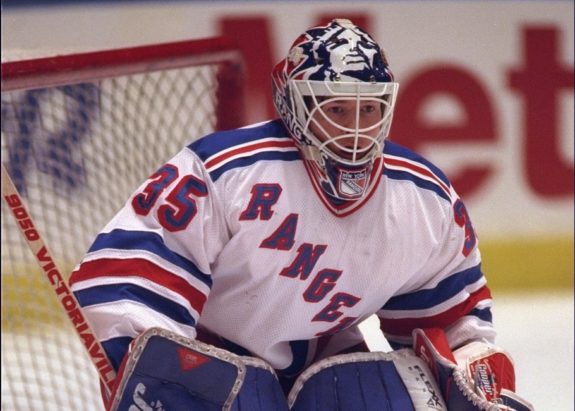
As great as he was during the regular season, Richter amped up his game for the Stanley Cup playoffs. In 23 games, Richter posted a 2.07 GAA and a .921 save percentage (SV%). He became just the eighth goaltender ever to have four shutouts in one playoff season. That fantastic run ended with the Rangers winning their first Stanley Cup in 54 years.
Richter remained one of the league’s top goaltenders for the next few years but was never able to repeat the success from the 1993-94 season. He was known for being one of the most focused goaltenders in the game. He played in the era of smaller and more athletic netminders and he had some of the quickest reflexes in the league.
Related – Best NHL Goalies of the 1980s
He played in 530 games for the Rangers during the decade and finished with a 2.85 GAA, .905 SV% and 22 shutouts. Richter appeared two All-Star Games to go along with his Stanley Cup win. However, he never won the Vezina Trophy. In 2008, he was inducted into the U.S. Hockey Hall of Fame alongside his Rangers teammate, Brian Leetch.
#4 Martin Brodeur
One may wonder how one of the greatest goaltenders of all-time is ranked fourth on this list. If this was the list of the best goaltenders of the 2000s, Martin Brodeur would be at the top because that is the decade in which he had his greatest success. Not to say the 1990s weren’t bad, but he was even better later in his career.
Brodeur’s rookie season, in 1993-94, set the standard for the rest of this Hall of Fame career. He won 27 games and finished the regular season with a 2.40 GAA and .915 SV%. His numbers were even better in the Stanley Cup playoffs as he led the Devils to the seventh game of the Eastern Conference Finals before being victimized by Stefan Matteau’s double-overtime goal. He was awarded the Calder Trophy following the season for being the top rookie in the NHL.
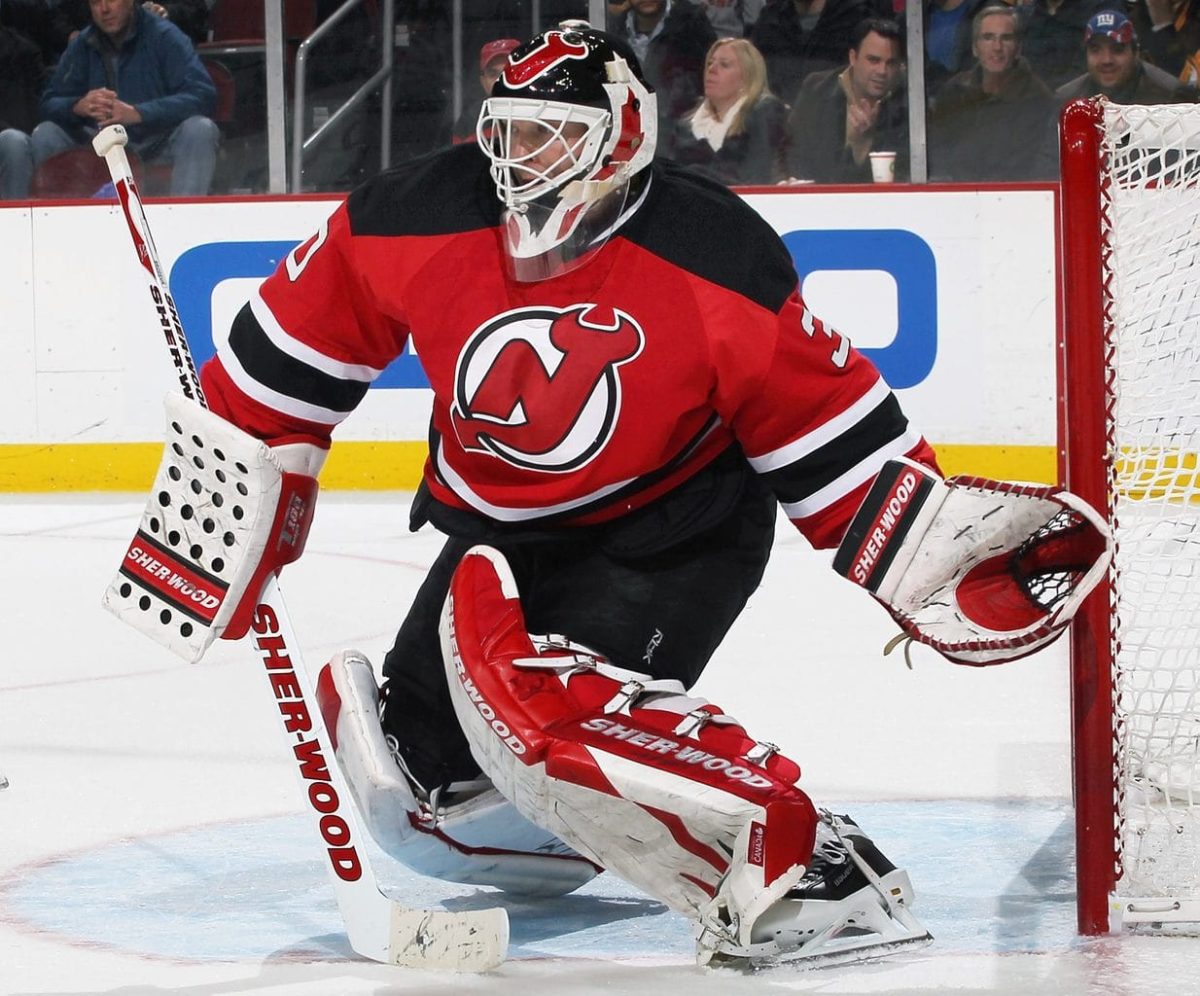
Brodeur won the first of three Stanley Cups, and only one of the 1990s, the following season. He went 16-4 during the postseason with a remarkable 1.67 GAA and .927 SV%. The Devils would only get out of the first round one time for the remainder of the decade, but that was hardly Brodeur’s fault.
The former first-round pick won back-to-back William Jennings, for allowing the fewest goals against, in 1997 and 1998, while finishing second in Vezina Trophy voting. He played in every All-Star Game between 1996 and 1999. Brodeur played in 447 games during the 1990s, finishing with a 2.20 GAA, .913 SV% and 42 shutouts.
He was known for his hybrid style of play by standing up more than your average butterfly goaltender. It was hard to tell which was his stronger attribute; puck handling or his deadly quick glove hand. You can thank Brodeur for the trapezoid behind NHL nets these days because his puck handling was the biggest reason they were installed.
#3 Ed Belfour
Goaltenders have always been known as some of the most colorful players in the game and none may have been more so than Ed Belfour. His explosive personality was only topped by his quick reflexes and glove hand. The majority of Belfour’s success game during the 1990s, which was spent playing for three different teams.
After appearing in nine Stanley Cup playoff games for the Chicago Blackhawks in 1990, he became the team’s starting goaltender for the 1990-91 season. During his rookie season, he led the league with 74 games played, 42 wins, a 2.47 GAA and .910 SV% on his way to the Calder, Vezina and Jennings Trophies. This would be the last time a goaltender led the league in wins, GAA and SV% in the same season until Carey Price did it in 2014-15.
Belfour dominated his way through the first three rounds of the 1992 playoffs, getting the Blackhawks to the Stanley Cup Final for the first time since 1973. However, the mighty Pittsburgh Penguins swept the Blackhawks who entered the series on an 11-game winning streak.
He went on to win the Vezina and Jennings Trophy in the same season again in 1992-93 and took home a third Jennings Trophy in 1994-95. The Blackhawks had to make a hard decision in 1997 after Belfour refused to sign a contract extension and they traded him to the San Jose Sharks. At the time of the trade, Belfour only trailed legends Glenn Hall and Tony Esposito in games played and wins in Blackhawks history.
After a rather lackluster half a season in San Jose, Belfour signed as a free agent with the Dallas Stars. He played in 67 games during his first season in Dallas and was tops in the NHL with a 1.88 GAA. He led the Stars to the Western Conference Finals before losing to the Detroit Red Wings.
The 1998-99 season produced the fourth and final Jennings Trophy for Belfour and ended with the only Stanley Cup win of his career. He went 16-7 with a 1.67 GAA, .930 SV% and three shutouts on his way the game’s top prize.
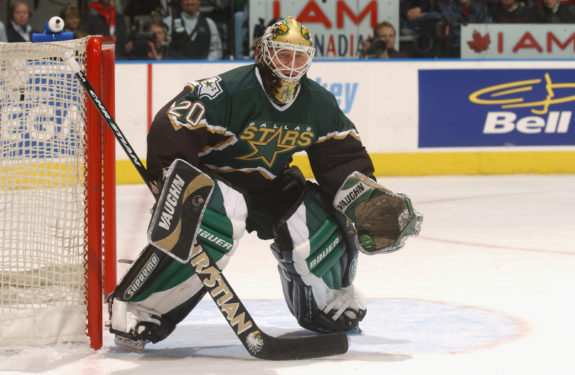
Belfour was one of the biggest workhorses of the 90s. If he was healthy, he was playing. He played in 589 games in the decade with a 2.42 GAA, .908 SV% and 49 shutouts. He won one championship, two Vezina and four Jennings Trophies. He also played in five All-Star Games.
#2 Patrick Roy
Few goaltenders have been more decorated and respected than Patrick Roy. His Hall of Fame career worked its way through three decades, with the 90s seeing a great deal of success. He is one of the first goaltenders to popularize the butterfly style which has become the dominant style used by netminders around the world.
The decade started with Roy winning the 1990 Vezina Trophy. It was the second straight season he took home the award for being the NHL’s top goaltender and he made it three-out-four seasons when he won it again in 1992.
The 1992-93 regular season was one of the worst of his career with a 3.20 GAA and .894 SV% in 62 games. However, the postseason was a completely different story. He went 16-4 with a 2.13 GAA and .929 SV% on his way to the second of three career Conn Smythe Trophies for being the most valuable player of the postseason and his second Stanley Cup victory.
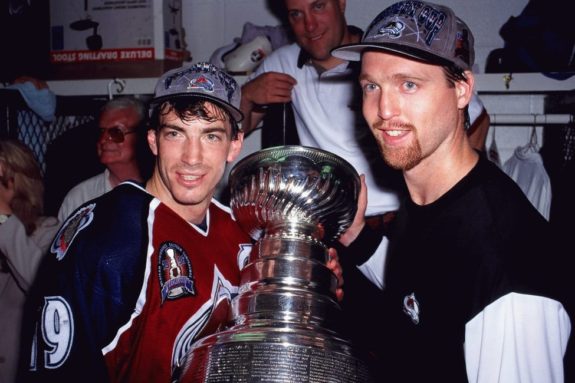
The Canadiens met their long-time rivals, the Boston Bruins, in the first round of the 1994 Stanley Cup playoffs. Roy had to miss Game 3 after coming down with appendicitis. He talked his way back in between the pipes for Game 4 and made 39 saves in a 5-2 victory. The Bruins went on to knock out the defending champs in seven games.
Roy’s time in Montreal famously came to an end on after a memorable night on Dec. 2, 1995. He was finally pulled by head coach Mario Tremblay, who had had a rocky relationship with, after allowing nine goals to the Red Wings. As he walked to the locker room, he yelled to team president Ronald Corey that that was his last game in Montreal.
Four days later, he was traded to the Colorado Avalanche, along with captain Mike Keane, in exchange for Jocelyn Thibault, Martin Rucinsky and Andrei Kovalenko. This deal remains one of the most one-sided trades in NHL history.
The trade completed the Avalanche’s Stanley Cup puzzle as Roy led the way to the 1996 championship, his second of the decade and third of four in his career. During the 1990s in Colorado, he won 40 playoff games with 2.37 GAA, .920 SV% and seven shutouts.
Roy played in all six games for Team Canada at the 1998 Winter Olympics in Nagano, Japan. Despite a 1.46 GAA and .935 SV%, Canada lost in the Bronze Medal game to Finland.
The 1990s was the best decade for one of the greatest netminders to ever lace up a pair of skates. He had a 2.56 GAA, .912 SV% and 36 shutouts in 600 games. He played in seven of the 10 All-Star Games in the decade, won two Vezina Trophies and had his name engraved on the Stanley Cup twice.
#1 Dominik Hasek
“The Dominator” didn’t win a Stanley Cup until 2002 in Detroit, but the 1990s is when he laid the foundation for a Hall of Fame career that ended with two championships, six Vezina Trophies and two Hart Trophies.
Hasek was originally drafted by the Chicago Blackhawks in the 10th round of the 1983 NHL Entry Draft. He made 28 saves in a 1-1 tie with the Hartford Whalers in his NHL debut on Nov. 6, 1990. He spent the 1991-92 season serving as Belfour’s backup in Chicago. He made an appearance in Game 4 of the 1992 Stanley Cup Final after Belfour allowed two goals on four shots.
Related – Best NHL Goalies of the 1970s
After the season, the Blackhawks decided to go with Belfour and Jimmy Waite, who is their current goaltending coach, in net and traded Hasek to the Buffalo Sabres for Stephane Beauregard and the draft pick that turned into Eric Daze.
Once given the starting job with the Sabres, Hasek became a star. He won his first Vezina and Jennings Trophies following the 1993-94 season where he led the league with a 1.95 GAA, .930 SV% and seven shutouts in 58 games.
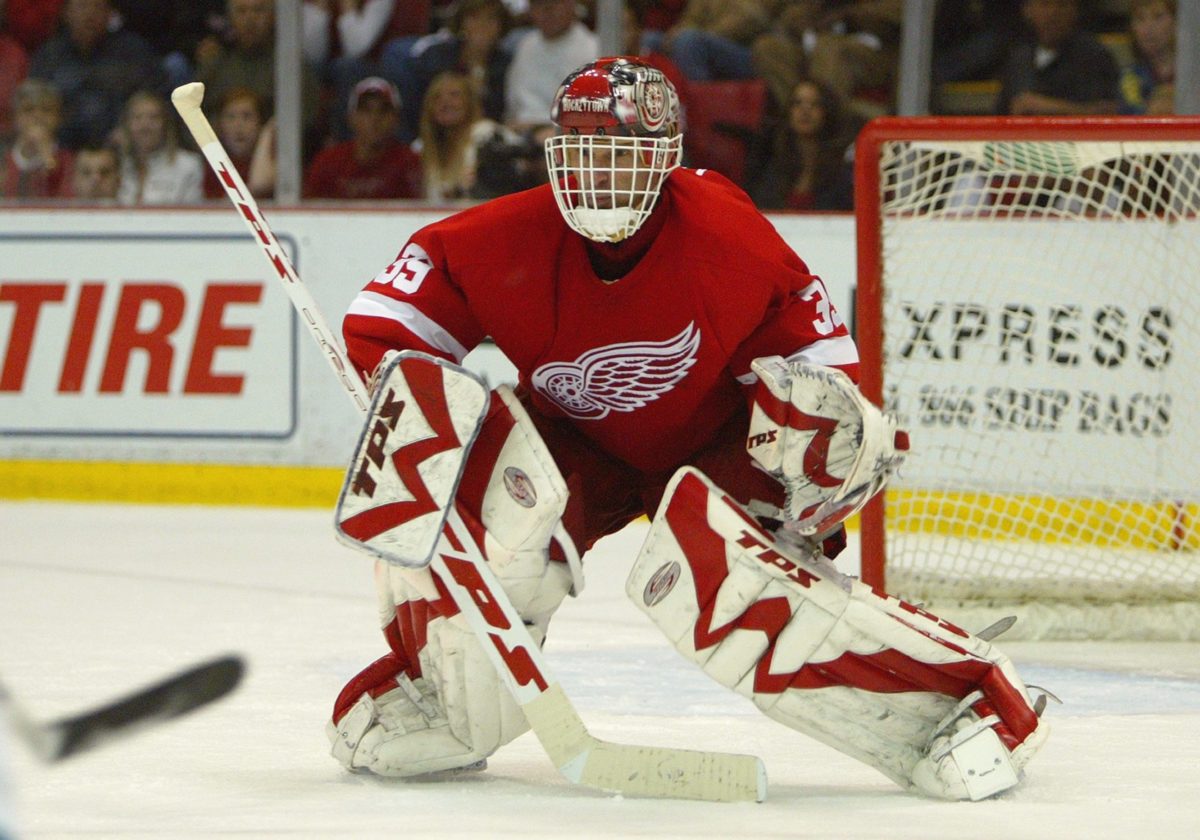
He went on to win his second Vezina Trophy in 1995 despite only playing in 41 games for posting another sterling .930 SV%. The following season, his numbers dipped a bit from the high standard he set, but he was still one of the top goaltenders in the game.
In 1996-97, he won both the Vezina and the Hart Trophies for another spectacular season, but much of that success was overshadowed by an ongoing feud with head coach Ted Nolan. Things came to a head during the playoffs when he removed himself from a first-round playoff game with a knee injury. He received a three-game suspension during the second round after an altercation with a local journalist who questioned his mental toughness.
He would be booed by Buffalo fans at the start of the 1997-98 season because his feud with Nolan, who won the Jack Adams Award for being the league’s top coach, led to his dismissal during the offseason.
Those boos did not last long as Hasek went on to win both the Vezina and Hart Trophies for the second straight season. He played in a career-high 72 games and set a franchise record with 13 shutouts. Six of those shutouts came during December, which tied the NHL record for the most in a single month. During the summer, he became the highest-paid goaltender in the league by signing a three-year, $26 million contract extension.
He closed out the decade by with his third straight Vezina Trophy for his remarkable 1.87 GAA and career-best .937 SV% in 64 games. He had a remarkable postseason leading the Sabres to their first and only Stanley Cup Final appearance.
The 1999 Stanley Cup Final between the Sabres and Stars made Blackhawks fans cringe as Hasek and Belfour manned their respective creases. The Stars won the series in six games. Hasek made 50 saves in the memorable Game 6; a triple-overtime loss that featured Brett Hull’s infamous game-winning goal.
In addition to his great body of work in Buffalo, he led the Czech Republic to the gold medal at the 1998 Winter Olympics. He gave up just six total goals during the tournament and only two during the medal rounds.
Hasek will be remembered for all his success just as much as his unconventional style of play. He was one of the most flexible goaltenders to ever play the game and was often seen flailing in the crease, using any and all body parts to keep the puck out the net. His flexibility allowed him to make saves that were flat out impossible for most to make.
During the 1990s, Hasek had a 2.26 GAA, .926 SV% and 45 shutouts in 449 games. He won half of the Vezina Trophies given out during the decade. He remains the only goaltender to ever win two Hart Trophies and he did it in back-to-back seasons. Of all the great goaltenders who played in the 1990s, Hasek was the best.
